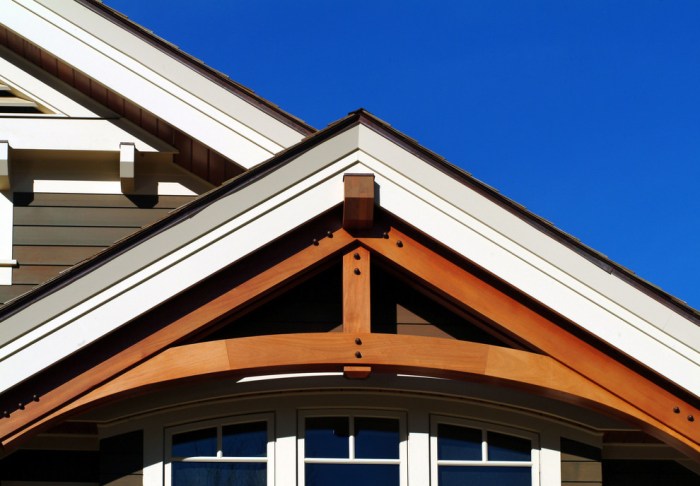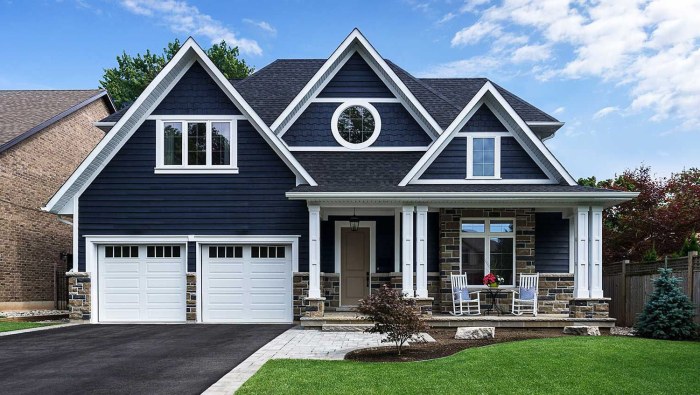Diving into the world of home exteriors roofing, this introduction aims to provide a detailed look at different aspects of roofing materials, design trends, maintenance tips, and eco-friendly options. Each section offers valuable insights to help homeowners make informed decisions about their roofs.
As we delve deeper, readers will gain a deeper understanding of the importance of choosing the right roofing materials, staying up-to-date with design trends, maintaining the roof properly, and considering eco-friendly options for a sustainable home exterior.
Types of Roofing Materials

When it comes to selecting roofing materials for your home exterior, there are several options to consider. Each type of material offers unique benefits in terms of durability and aesthetic appeal.
Asphalt Shingles
Asphalt shingles are one of the most popular roofing materials due to their affordability and ease of installation. They come in a variety of colors and styles, making them a versatile option for different home designs. While asphalt shingles have a moderate lifespan of around 20-30 years, they may require more frequent maintenance and are prone to damage from severe weather conditions.
Metal Roofing
Metal roofing is known for its exceptional durability and longevity, with some materials lasting up to 50 years or more. It offers superior protection against elements such as wind, rain, and snow, making it a great choice for homeowners looking for long-term value.
Metal roofs also come in a range of styles, including standing seam and corrugated panels, adding a modern and sleek look to your home exterior.
Clay Tiles
Clay tiles are a popular choice for homeowners seeking a more traditional and elegant appearance for their roofs. These tiles are known for their durability and resistance to fire, rot, and insects. While clay tiles can last up to 50 years or more, they are heavier than other materials and may require additional structural support.
Their distinct terracotta color adds a Mediterranean flair to the home exterior, enhancing its overall curb appeal.
Roofing Design Trends

When it comes to modern home exteriors, roofing design trends play a crucial role in enhancing the overall aesthetic appeal and functionality of the house. From innovative styles like green roofs to the practicality of solar panels, there are various options homeowners can explore to make a statement with their roof.
Green Roofs
Green roofs, also known as living roofs, are becoming increasingly popular among eco-conscious homeowners. These roofs are covered with vegetation, providing insulation, reducing energy costs, and promoting environmental sustainability. Not only do green roofs offer a unique and visually appealing look, but they also contribute to a healthier environment.
Solar Panels
With a growing emphasis on renewable energy sources, solar panels have become a popular choice for roofing design. By harnessing the power of the sun, solar panels not only generate electricity for the home but also reduce utility bills and carbon footprint.
Integrating solar panels into the roof design can add a modern and futuristic touch to the exterior of the house.
Color Choices and Textures
Color choices and textures play a significant role in defining the style and character of a home's exterior. Light-colored roofs can reflect sunlight and heat, keeping the interior of the house cool during hot weather, while dark-colored roofs absorb heat, providing warmth in colder climates.
Textured roofing materials, such as cedar shakes or metal tiles, can add depth and visual interest to the roof, enhancing the overall curb appeal of the home.
Maintenance Tips for Home Exteriors
Regular maintenance is essential to ensure the longevity and durability of your home's roof. By following a few simple steps, you can keep your roof in good shape and prevent costly repairs in the future.
Cleaning Your Roof
- Remove debris such as leaves, branches, and dirt regularly to prevent clogging of gutters and downspouts.
- Use a gentle cleaning solution and a soft-bristled brush to remove mold, mildew, and algae growth.
- Avoid using pressure washers, as they can damage the shingles and underlying materials.
Inspecting for Damage
- Check for loose or missing shingles, cracked tiles, or damaged flashing around chimneys and vents.
- Look for signs of water damage, such as water stains on the ceiling or walls inside the house.
- Inspect the attic for any signs of leaks, such as water spots or damp insulation.
Repairing Common Roofing Issues
- Replace any damaged or missing shingles promptly to prevent water infiltration and further damage.
- Repair or replace damaged flashing to ensure a watertight seal around chimneys, skylights, and vents.
- Address any sagging or uneven areas on the roof, as they can indicate underlying structural issues.
Importance of Regular Maintenance
Regular maintenance not only helps extend the lifespan of your roof but also helps identify and address small issues before they escalate into major problems. By investing time and effort in maintaining your roof, you can save money in the long run and ensure the protection of your home and belongings.
Eco-Friendly Roofing Options
When it comes to sustainable home exteriors, choosing eco-friendly roofing materials can have a significant impact on the environment. These options not only help reduce your carbon footprint but also provide long-term benefits for your home.
Green Roofs
Green roofs, also known as living roofs, involve planting vegetation on the roof surface. These roofs help absorb rainwater, reduce urban heat island effect, improve air quality, and provide insulation for the building.
Cool Roofs
Cool roofs are designed to reflect sunlight and absorb less heat compared to traditional roofs. By keeping the roof surface cooler, cool roofs can reduce energy costs, minimize heat retention in urban areas, and extend the lifespan of the roof.
Recycled Shingles
Using recycled materials like rubber, plastic, or wood fibers to create shingles is another eco-friendly option. These shingles are durable, energy-efficient, and help reduce waste in landfills. They can also be made from reclaimed materials, further enhancing their sustainability.
Final Review
In conclusion, home exteriors roofing is a crucial aspect of any home's design and functionality. By understanding the various elements discussed in this guide, homeowners can enhance the aesthetics, durability, and eco-friendliness of their roofs, ultimately adding value to their properties.
Answers to Common Questions
What are the key factors to consider when choosing roofing materials?
Consider factors like durability, aesthetic appeal, climate suitability, and maintenance requirements when selecting roofing materials.
How often should I inspect my roof for maintenance?
It's recommended to inspect your roof at least twice a year, preferably in the spring and fall, to catch any issues early.
What are the benefits of eco-friendly roofing options?
Eco-friendly roofing options can improve energy efficiency, reduce environmental impact, and contribute to a sustainable home design.
























